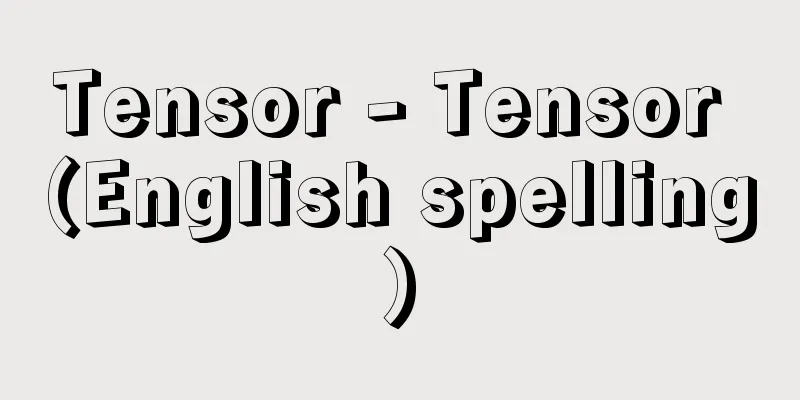Tensor - Tensor (English spelling)

|
It is an extension of the concept of vectors, and is a concept that plays an important role in mathematics, especially geometry and physics. The word comes from "tension." Vectors, matrices, and inner products are representative basic concepts. These were originally separate concepts, but as described below, once the concept of tensors is introduced, they can be treated as part of the same family in a unified manner. First, let R denote the set of real numbers, and let V be an n -dimensional vector space on R ( the n- dimensional Euclidean space Rn is a representative example of V ). Let r be a natural number. Let T be a mapping from V 's r- element Cartesian product V ×…× V to R. In other words, let us assume that a unique real number T ( X1 ,…, Xr ) is defined each time r elements X1 , …, Xr of V are determined. In this case, if we fix the number i (=1,…, r ) and the elements X1 ,…, Xi - 1 , Xi + 1 ,…, Xr of V , then each time an element X of V is determined, an element T ( X1 ,…, Xi - 1 , X , Xi + 1 ,…, Xr ) of R is determined . An r -th tensor T on V can be quantitatively expressed as follows. If we define a base { e1 , …, en } for V , then all elements of V can be expressed in a single way as x1e1 +…+ xnen ( x1 ,…, xn are elements of R ) . If we denote r × n real numbers by xij ( i = 1,…, r ; j = 1 ,…,n ) and let the indices i1 ,…, ir run from 1 to n , then we obtain the following from the definition of a tensor.
[Example 1] The set of first-order tensors on V is nothing other than the dual space V * of V. It is also known that the set of first-order tensors on V * can be regarded as V. [Example 2] Let T be a second-order tensor on V. The components of T for one base of V consist of n2 real numbers . Therefore, for each base defined for V , we see that there is a one-to-one correspondence between all second-order tensors on V and all second-order real square matrices. Also, a (positive definite) inner product on V is a second-order tensor T on V that satisfies the following: (1) For all elements X and Y in V , T ( X , Y )= T ( Y , X ) and T ( X , X )0 [ Example 3] Let X1 ,…, Xn be any elements of Rn . For i = 1,…, n , let Xi = ( xi1 ,…, xin ) . If we denote the nth order square matrix with xij ( i , j = 1,…, n ) as X and let T ( X1 ,…, Xn ) = det X , we can see that T is an nth order tensor over Rn . [Ryoichi Takagi] Tensor quantities in physics The components ( x , y , z ) of the position vector r of a mass point have different values depending on the coordinate system used. When the three axes of a Cartesian coordinate system are rotated by a certain angle around an axis that passes through the origin and transferred to a new coordinate system, the coordinates ( x , y , z ) of the mass point change to different values ( x ' , y ', z '). If we write x1 , x2 , x3 instead of x , y , z , The components of the velocity V of a mass point undergo the exact same transformation. A quantity that undergoes the same transformation as r when a coordinate system rotates is called a first-order tensor or vector. The position, velocity, and acceleration of a mass point are first-order tensors. When there are two first-order tensors A and B , a quantity with nine components A i B j ( where i and j take the values 1, 2, or 3) is called a second-order tensor. In general, when there is a quantity T ij with nine components that undergoes the same transformation as A i B j when a coordinate system rotates, T ij is called a second-order tensor. In particular, when T ij = T ji , it is called a second-order symmetric tensor. There are six independent components. When T ij = - T ji , it is called an antisymmetric second-order tensor. There are three independent components. The angular momentum of a mass point is an example of an antisymmetric second-order tensor. The square of the magnitude of a position vector r , r2 , is a quantity that does not change when the coordinate system is rotated and is called a zero-order tensor or scalar. Examples of this type of quantity include charge and mass. In general, we can think of an n -order tensor that transforms like the product of n vectors. Newton's law of motion states that the change in momentum over time is equal to force, but since both are first-order tensors (vectors) and transform in the same way even when the coordinate system is rotated, this law holds true regardless of the choice of the axes of the rectangular coordinate system. In general, the fundamental laws of physics state that different tensor quantities of the same order are equal, and therefore hold true regardless of the choice of the coordinate axes. [Akira Takeda] [References] | | | | | |Source: Shogakukan Encyclopedia Nipponica About Encyclopedia Nipponica Information | Legend |
|
ベクトルの考え方を拡張したもので、数学、とくに幾何学や、物理学で重要な働きをする概念。張力tensionに由来することば。ベクトル・行列・内積といえば、代表的な基本的概念である。これらは、本来別々に生まれた概念であるが、以下述べるようにひとたびテンソルという概念を導入すると、同じ仲間として統一的に取り扱えるのである。 まず実数の全体をRで表し、VをR上のn次元ベクトル空間とする(n次元ユークリッド空間RnはVの代表例である)。rを自然数とする。TをVのr個の直積V×…×VからRへの写像とする。すなわち、Vのr個の元X1,…,Xrを決めるたびに実数T(X1,…,Xr)がただ一つ定められているとする。このとき、番号i(=1,…,r)とVの元X1,…,Xi-1,Xi+1,…,Xrを固定しておくと、Vの元Xを決めるたびにRの元 V上のr次テンソルTは次のようにして数量的に表記できる。Vに一つの基{e1,…,en}を定めておくと、Vの元はすべてx1e1+…+xnen(x1,…,xnはRの元)の形で一通りに表せる。r×n個の実数をxij(i=1,…,r;j=1,…,n)で表し、添え字i1,…,irは1からnまで動くものとすると、テンソルの定義から次が得られる。
〔例1〕V上の1次テンソルの全体はVの双対空間V*にほかならない。また、V*上の1次テンソルの全体はVとみなせることが知られている。 〔例2〕TをV上の2次テンソルとする。Vの一つの基に関するTの成分はn2個の実数からなっている。したがって、Vに一つ基を定めるたびに、V上の2次テンソルの全体と2次実正方行列の全体の間に1対1の対応があることがわかる。また、V上の(正定値)内積とは、V上の2次テンソルTで、次を満たすもののことである。 (1)Vのすべての元XとYに対してT(X,Y)=T(Y,X)かつT(X,X)0 〔例3〕X1,…,XnをRnの任意の元とする。i=1,…,nに対して、Xi=(xi1,…,xin)とおく。xij(i,j=1,…,n)を成分とするn次正方行列をXで表して、T(X1,…,Xn)=detXとおけば、TはRn上のn次テンソルであることがわかる。 [高木亮一] 物理学におけるテンソル量質点の位置ベクトルrの成分(x,y,z)は座標系のとり方により値が異なる。直角座標系の3軸を、原点を通るある軸の周りに、ある角度回転させて新しい座標系に移させると、質点の座標(x,y,z)は別の値(x',y',z')に変化する。x、y、zのかわりにx1、x2、x3と書くと、 質点の速度Vの成分もまったく同じ変換をする。rと同一の変換を、座標系の回転に対して行う量を1階のテンソルまたはベクトルとよぶ。質点の位置、速度、加速度などは1階のテンソルである。二つの1階テンソルA、Bがあるとき、9個の成分をもち、その成分がAiBj(i、jは、1、2、3のいずれかの値をとる)である量を考え、2階のテンソルという。また一般にAiBjと同一の変換を座標系の回転に対して行う9個の成分をもつ量Tijがあるとき、Tijを2階のテンソルという。とくにTij=Tjiのとき2階の対称テンソルという。独立な成分は6個である。またTij=-Tjiのとき2階の反対称テンソルという。独立な成分は3個になる。質点の角運動量は2階の反対称テンソルの例である。位置ベクトルrの大きさの平方r2は座標系の回転により変わらぬ量で零階のテンソルまたはスカラーとよぶ。この種の量として電荷、質量などがある。一般にn個のベクトルの積のように変換するn階のテンソルを考えることができる。 ニュートンの運動法則は運動量の時間変化が力に等しいとしたものであるが、この両者は1階のテンソル(ベクトル)であり、座標系を回転しても同じように変換するので、直角座標系の軸のとり方によらずに成立する。一般に物理学の基礎法則は同じ階数の異なるテンソル量を等しいと置いたもので、座標軸のとり方によらずに成立する。 [武田 暁] [参照項目] | | | | | |出典 小学館 日本大百科全書(ニッポニカ)日本大百科全書(ニッポニカ)について 情報 | 凡例 |
<<: The myth of the descent of the grandson of heaven
>>: Emperor Tianzuo (English: Emperor Tianzuo)
Recommend
Kyoto Shoku - Kyoshiki
An office that was in charge of the administratio...
Villach (English spelling)
A small city in Carinthia in southern Austria. Loc...
Oyano Bridge - Oyanobashi
…Five bridges at key points on the Amakusa Pearl ...
Kakeme - Kakeme
〘noun〙① Weight measured on a scale. Weight. Quanti...
Depressed - Uccho
Liquor scented with tulips. Used in rituals. In br...
Donatello
A representative sculptor of the early Italian Ren...
Cowley, Abraham
Born: 1618, London [Died] July 28, 1667. Chesey, S...
Test Competition - Genkurabe
Monks and ascetics split into two groups, left and...
Larval reproduction - larval reproduction
This is a form of parthenogenesis, in which repro...
Exhaust turbine - exhaust turbine
This refers to a gas turbine that runs on the exha...
Contraction ring
...If the birth canal fails to open or if the fet...
Jihei Sugimura
Years of birth and death unknown. Edo ukiyo-e art...
mamlaka
...Of course, daula is a concept centered on the ...
Amblyseius eharai (English spelling)
… [Shozo Ehara]. … *Some of the terminology that ...
Koshi [town] - Koshi
A former town in Kikuchi County in northern Kumamo...









